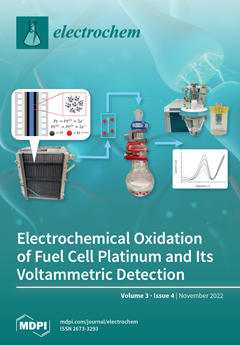In this study, an electrochemical sensor for the monitoring of Hg (II) at trace levels by using differential pulse anodic stripping voltammetry has been reported. Basically the electrochemical sensor is a
Phanerochaete chrysosporium-based carbon paste electrode. Here,
Phanerochaete chrysosporium has played a
[...] Read more.
In this study, an electrochemical sensor for the monitoring of Hg (II) at trace levels by using differential pulse anodic stripping voltammetry has been reported. Basically the electrochemical sensor is a
Phanerochaete chrysosporium-based carbon paste electrode. Here,
Phanerochaete chrysosporium has played a new vital role in electrochemical detection of heavy metal apart from its known contribution in their removal. Optimal voltammetric response was observed at −0.7 V deposition potential l, 5% biomass concentration ratio (
w/
w), and neutral pH conditions with 12 min as the accumulation time. Selectivity was evaluated in the presence of different interfering cations. Linear range was observed for 5–50 µgL
−1 of metal concentration with a detection limit of 4.4 µgL
−1. The equivalence of new and reference analytical methods was statistically assessed in mercury samples collected from chlor-alkali industrial effluent by correlation of results (Pearson’s product-moment correlation), weighted Deming regression analysis, paired comparison test, relative standard deviation (RSD), median relative error (MRE), root mean square error (RMSE), and predicted residual sum of square (PRESS). This work presented a simple, efficient, and promising analytical tool in trace level detection of Hg (II), as compared to previously reported carbon paste electrodes based on biological material.
Full article




